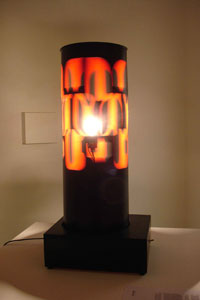The Dreamachine
David Woodard
Position yourself beside the Dreamachine. Close your eyes, holding your face as close as possible to the rotating cylinder. Visual effects begin immediately, in terms of fantastic pulsating mandalas, but have patience—the experience becomes interesting within 10 to 15 minutes. Think about what you are seeing—and why you are doing this. Subtly, perhaps meaningfully, you will notice that you are thinking new thoughts. This is how naughty apes, defying a jealous God by sitting under the flickering Tree of Knowledge, figured out how to talk, make tools and weapons, become human and kill God.
In the religious history of the Ayran race in Europe, worship of the flickering tree has played a crucial role. Nothing could be more natural. At the dawn of history, Europe was covered with immense primaeval forests, in which the scattered clearings must have appeared as islets in a pulsating ocean of green. Down to the first century before our era, the Hercynian forest stretched eastward from the Rhine for a distance vast and unknown; Germans whom Caesar questioned had traveled for months through this flicker source without reaching end. Four centuries later, it was visited by the Emperor Julian, and the solitude, the gloom, the silence of the forest appear to have made a deep impression on his sensitive nature. Julian declared that he knew nothing like it in the Roman empire. In England, the wealds of Kent, Surrey, and Sussex are remnants of the great forest of Anderida, which once clothed the whole of the island’s south-eastern portion. Westward it seems to have stretched until joining another forest that extended from Hampshire to Devon. In the forest of Arden, it was said that down to modern times a squirrel might leap from tree to tree for nearly the entire length of Warwickshire. The excavation of ancient pile-villages in the valley of the Po has shown that long before the rise and probably the foundation of Rome, the north of Italy was covered with densely flickering woods of Elm, Chestnut and especially Oak. The effects of the sun piercing through these swaying behemoths onto the closed eyelids of heathen supplicants were more or less identical to those of a beautifully primitive contraption invented some centuries later by the English mathematician Ian Sommerville and the Canadian-Islamic poet Brion Gysin, in 1959.
Based on Gysin's divinitory use of Sufic geometry, the Dreamachine is a motorized lamp that relies on the flickering of Ishmaelite archetypes to yield an oracular state. American novelist William S. Burroughs, a devout champion of Hassan I Sabbah (Nothing is true, everything is permitted), made extensive use of the Dreamachine as a source of inspiration throughout his career.
In China, it has been customary from time immemorial to plant trees on graves in order to strengthen the soul of the deceased and thus save his or her body from perdition—and as the swaying evergreen cypress and pine are deemed fuller of psychoactive vitality than other trees, they have been chosen by preference for this purpose. Hence, flicker-producing trees towering over graves are sometimes identified with the souls of the departed. Among the Maraves of Southern Africa, the burial ground is regarded as a holy place where nary a tree may be felled—trees are tenanted by souls of the dead, like the tunnels of Eyes of Isis and/or swastikas a sensitive soul will find very much alive and eager to communicate in a proper Dreamachine experience.
In most if not all of these cases, the spirit is incorporate in the tree—it animates the tree and must suffer and die with it. But according to another and probably later opinion, the mysteriously wisened tree is not the body but rather the abode of the tree spirit, which may depart and return at will. The inhabitants of Siaoo, an East Indian island, believe in certain sylvan spirits who dwell in forests or in great solitary trees. At full moon, the spirit comes forth from his lurking place and roams about—identified by his large head, longish arms and legs and ponderous body. In hopes of pleasing these wood spirits, people bring offerings of wine, fowl and freshly slaughtered goats to the places the spirits are known to inhabit.
In the Moluccas, when the clove trees are in blossom, they are treated as pregnant women. No sound may be produced in their midst, no fire carried past them at night, no man may approach them whilst donning a hat—all must uncover and bow in their presence. These precautions are observed lest the tree be annoyed and passive-aggressively bear no fruit, or sarcastically drop its fruit too soon—like the untimely delivery of a woman jilted in pregnancy. If the tree is deeply offended, the village is inevitably wiped out.
Initially, most users observe something akin to a perpetually metamorphosing Persian rug. Fifteen minutes or so later, entoptic effects segue into a series of cinematic images, as the brain endeavors to find order in an otherwise endless, abstract chaos. During this process, the sensitive user enters a kind of lucid dream state.
Normally, an awake person's brain functions at between 4 and 8 electrical pulses per second (hertz, or hz). When the Dreamachine's 10 flickers per second strike closed lids, the optic nerve sends a 10 hz pulse signal into the cortical tissue. Because the amplitude of the newly introduced signal is greater than that of a waking brain's normal frequency, much of the waking brain’s tissue now operates at 10 hz, the synaptic rate associated with the edge of dreams.
It is almost interesting to consider the history of flicker and the Dreamachine's functional prototypes. Aside from physiologist W. Grey Walter's astonishing postulate that the Old Testament's "Tree of Knowledge" is a shrouded reference to the Sun's piercing rays interrupted by swaying leaves and branches—and that the resultant flicker's contemplative effects on sensitive higher primates are the genesis of human consciousness, the Renaissance observed an overt flurry of optic nerve-related occult activity within the Catholic Church.
In 1564, Nostradamus began conducting phalangeal / flicker experiments at the bequest of Catherine de' Medici, who had recounted to the burgeoning prognostigator legends of Lucrezia Borgia's subtle use of flames to divine and control future events. Mme. Borgia was granted complete dominion over the Vatican by her father, Pope Alexander VI, at a time when she is known to have privately experimented with the behaviors of fire. Though she is the most widely known early exponent of flicker magic, perhaps willful Lucrezia is merely the most historically scrutinized in a papal lineage deeply fraught with clergy and relations secretly devoted to flame enchantment—which, during the Middle Ages, entitled even the mildly indiscreet to a complimentary burning at stake.
Is flickering light delivered to humankind from a higher place?
"They say", writes ancient vegetarian Porphyry, "that primitive men led an unhappy life, for their superstition did not stop at animals but extended withal to plants. For why should the slaughter of an ox or sheep be a greater wrong than the felling of an Oak or Fir, especially in light of the greater soul residing within these arboreal pedagogues?" Likewise, the Hidatsa Indians of North America believe that every natural object has its spirit, its shade. To these shades some consideration or respect is due, but not equally to all. The shade of a Cottonwood, the greatest tree in the valley of the Upper Missouri, possesses an intelligence which, if properly negotiated, may assist the Indians in important undertakings; and yet the shades of shrubs and grasses are of little account. Until recently, some of the more credulous old coots declared that the misfortunes of their people were caused by this modern disregard for the civil rights of the caring Cottonwood. The Wanika of Eastern Africa fancy that every tree, and especially every Coconut tree, is a voice of God; the destruction of a Coconut tree is considered equivalent to matricide—the tree offers them visionary reassurance and nourishment, as a mother does her child. Siamese monks, believing that there are souls everywhere, and that to destroy anything whatsoever is to forcibly dispossess a soul, are less likely to break a branch of an instructive tree than to break an arm of an innocent child. These monks are Buddhists.
The Wishing Machine
When author G. Harry Stine chose to include the Wishing Machine in his On the Frontiers of Science (New York: Simon & Schuster, 1985), he claimed to be very hesitant—due in part to the machine's inexplicable effectiveness. To properly use the Wishing Machine, one places a wish (in the form of text, representative image and/or a diorama consisting of small objects) between the copper plates, flips the switch and waits. That's all you do—no complicated dial settings. The copper-plated chamber serves as a capacitor, ultimately charging the outer ether with the contents informing its amplified signal. With the addition of fur, Stine's otherwise merely electronic gadget becomes orgonomically active, per Wilhelm Reich's theory that alternating layers of organic and inorganic material (e.g., fur and copper) will yield Orgone energy. Like electricity, Orgone pervades the etheric realm in which we live. A wish placed in the fur-lined copper chamber now transmits two distinct types of subtle organic signal – working together in tandem.


The Dreamachine (left) and the Wishing Machine (right)